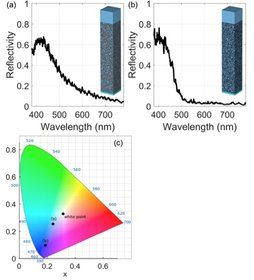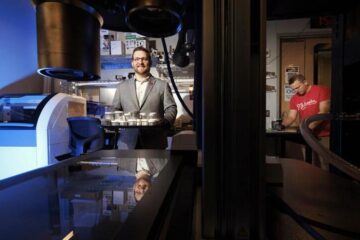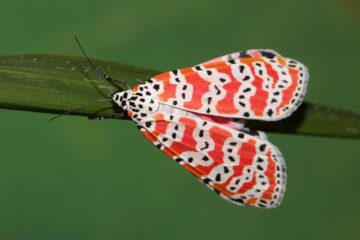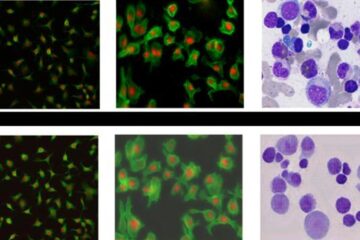New concept for structural colors

Abbildung: Vergleich der berechneten Reflexionsspektren zweier photonischer Gläser, einmal bestehend aus keramischen Vollkugeln (a) und einmal aus keramischen Hohlkugeln (b). Die Kugeldurchmesser betragen ca. 200 Nanometer und die Schalendicke der Hohlkugeln in (b) ca. 10 Nanometer. Das rechte Bild zeigt ein wesentlich steileres Reflexionsspektrum, das eine bessere Farbsättigung der in diesem Fall blauen Farbe bedingt. Die beiden Quader zeigen Ausschnitte der mit Kugeln befüllten Volumina, mittels derer die numerischen Simulationen durchgeführt wurden. (b) Chromatizitätsdiagramm. Die Positionen der beiden Reflexionsspektren in (a) und (b) sind in Relation zum farblosen Weißpunkt eingetragen. Auf dem Umfang des Diagramms sind die reinen Farben gezeigt. Das aus Hohlkugeln bestehende photonische Glas erzeugt eine Farbe, die im Vergleich zu dem aus Vollkugeln bestehenden photonischen Glas wesentlich näher am Umfang liegt – also viel reiner ist.
In contrast to conventional pigments, the color effect is not caused by the absorption of certain wavelengths, which are in turn missing from the reflection spectrum and thus cause the color impression. Structural colors generate color solely by a structure that lets certain wavelengths destructively interfere.
Often such pigments feature a color impression that is dependent on the direction of illumination as well as the angle under which the pigment is looked at. This one wants to prevent in many cases. To realize “non-iridescent” colors, a certain amount of disorder in the structural arrangement of the colorant is needed. However, this disorder has lead, so far, to only weakly saturated colors.
The group of Hamburg based scientist have managed now to resolve these conflicting requirements. For this purpose a new concept was developed, which is based on weakly ordered arrangements of spheres – a so called photonic glass – combined with a precise design of the spheres themselves.
The utilized hollow spheres have a diameter of around 200 nanometers with a ceramic shell of only around 10 nanometers thickness. Only the combination of the nearest neighbor ordering of these densely packed spheres and the hollow sphere character of the single particles allow a steep edge of the reflection spectrum (Figure 1b). The usefulness of this design approach is exemplified with a highly saturated blue color.
The photonic glass from hollow sphere particles produces a blue color much closer to the perimeter of the chromaticity diagram, thus a much purer color than that of the photonic glass from homogeneously filled spheres (Figure 1c). The team of researchers developed the theoretical framework for the description of this novel class of colorants and confirmed their predictions with extensive numerical simulations.
These principal findings which were produced under the lead of the scientists from Hamburg are further of importance for the development of non-toxic colorants, which also do not bleach under sun light and which are suited for high processing temperatures beyond 1000°C.
The manuscript was published in Scientific Reports, an Open Access-Journal of Nature.
Online: www.nature.com/articles/s41598-018-26119-8
Publication:
Guoliang Shang, Lukas Maiwald, Hagen Renner, Dirk Jalas, Maksym Dosta, Stefan Heinrich, Alexander Petrov, and Manfred Eich,
Photonic glass for high contrast structural color,
Scientific Reports, 8, 7804 (2018)
Further Information
Prof. Dr. Manfred Eich
Technische Universität Hamburg-Harburg (TUHH), Institut für Optische und Elektronische Materialien, Eißendorfer Straße 38, D-21073 Hamburg
und
Institut für Werkstoffforschung, Helmholtz-Zentrum Geesthacht, Max-Planck-Strasse 1, Geesthacht, D-21502, Germany,
Tel +49 40 42878 3147
E-Mail: m.eich@tuhh.de,
Website: www.tuhh.de/alt/oem/home.html
Media Contact
More Information:
http://www.tuhh.deAll latest news from the category: Materials Sciences
Materials management deals with the research, development, manufacturing and processing of raw and industrial materials. Key aspects here are biological and medical issues, which play an increasingly important role in this field.
innovations-report offers in-depth articles related to the development and application of materials and the structure and properties of new materials.
Newest articles

Bringing bio-inspired robots to life
Nebraska researcher Eric Markvicka gets NSF CAREER Award to pursue manufacture of novel materials for soft robotics and stretchable electronics. Engineers are increasingly eager to develop robots that mimic the…

Bella moths use poison to attract mates
Scientists are closer to finding out how. Pyrrolizidine alkaloids are as bitter and toxic as they are hard to pronounce. They’re produced by several different types of plants and are…

AI tool creates ‘synthetic’ images of cells
…for enhanced microscopy analysis. Observing individual cells through microscopes can reveal a range of important cell biological phenomena that frequently play a role in human diseases, but the process of…





















